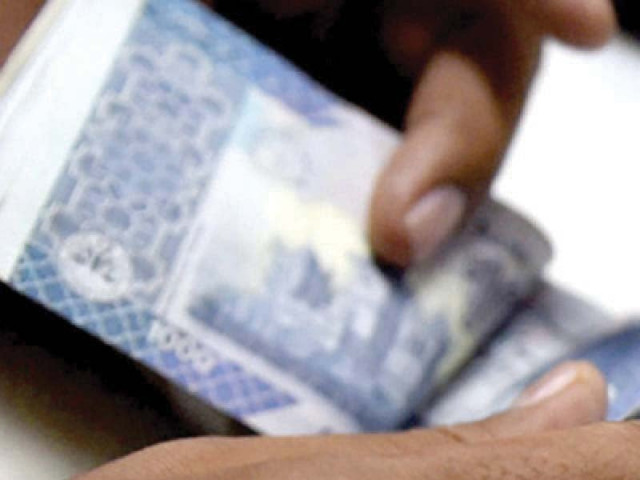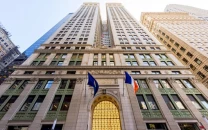Rupee becomes worst performer in Asia
Currency drops to 13-month low of 166.98 to a dollar in inter-bank market

Pakistani rupee has become the worst-performing currency in Asia compared to its status as world’s best performer six months ago, as it hit a 13-month low of Rs166.98 against the US dollar in the inter-bank market due to a surge in demand for the greenback to pay for imports.
The local currency has depreciated almost 10% (or Rs14.71) in the past four months, becoming the “worst performer in Asia ... (in) a basket of 13 currencies compiled by Bloomberg,” Bloomberg reported on Thursday.
The rupee hit a 22-month high of Rs152.27 in May 2021 but since then it has been on a downturn.
Earlier in March 2021, it emerged as the world’s best-performing currency, when it appreciated the most (4.09% to Rs153.55) against the US dollar from the opening level of January 1, 2021.
Arif Habib Limited Head of Research Tahir Abbas said that the trade deficit, which widened to a record high of over $4 billion in August 2021, “suggests that demand for foreign currency has remained significantly high for soaring import payments compared to sluggish export earnings.”
“The situation took a toll on the Pakistani rupee,” he told The Express Tribune.
“This (rupee becoming Asia’s worst performer) is surprising,” AKD Securities CEO Farid Alam said while talking to The Express Tribune.
The world market ran on perception and “we and the media are developing a negative perception (of the Pakistani currency) these days,” he said.
He was surprised to note that the rupee maintained its downtrend on the day (August 24) the country received a significant amount of $2.75 billion from the International Monetary Fund (IMF).
“The rupee has dropped 10% on conspiracy theories like the IMF has set the condition for Pakistan to let the currency depreciate to 170 to resume the $6 billion loan programme,” he said. “Otherwise, nothing bad has happened (in the economy).”
The real effective exchange rate (REER) – the country’s cost of external trade – “is standing at a manageable level of 99 points on the index, meaning import and export pricing with our trade partners is perfect and the situation is not tense.”
He stressed the need for taking a deeper look at the widening trade deficit caused by soaring imports. “There is a need to check whether the imported goods include plant and machinery for industrialisation or they comprise luxury goods like cars or non-essential items,” he said.
“Many industrialists have imported machinery, which is good for expansion of the economy.”
At the same time, there is a need to check non-essential goods imports as well.
Read Market watch KSE-100 dives owing to food inflation, rupee fall
The rupee and stock markets are on the decline on the perception that political tensions between Pakistan and the US are building. It is also believed that it may lead to the permanent suspension of the IMF loan programme, “which is incorrect”.
“Pakistan has clarified that it will not exit the programme and strongly expects to see its resumption this month, ie September,” he said.
Alam said that the central bank should intervene in limited capacity to extend support to the rupee “as we remain an economy in which market players exploit the situation”.
The country’s foreign currency reserves have hit an all-time high of over $20 billion. “They should not be put in a showcase rather they should be sold in the inter-bank market to support the rupee and the central bank should buy dollars when the rupee regains its value,” he said.
The rebound in international oil prices and soaring LNG prices in the world market are leading to an increase in the demand for US dollars and mounting pressure on the rupee. “Energy imports remain necessary compared to non-essential or luxury items,” he said.
AHL’s Abbas said that the inter-bank market depended on the demand and supply of dollars. “The rupee is expected to consolidate at around Rs165-67 under the current spell soon.”
The record high trade deficit in August suggested that the current account deficit would amount to around $1-1.5 billion in the month, he said.
The rupee may partially recover the lost ground ahead of the resumption of IMF programme, on the back of robust workers’ remittances, Roshan Digital Account (RDA) inflows, likely reduction in import payments and a surge in exports, he said.
“The massive surge in import payments in August seems to be one-off, while exports remain dull due to higher number of holidays in the month,” he said.
Published in The Express Tribune, September 3rd, 2021.
Like Business on Facebook, follow @TribuneBiz on Twitter to stay informed and join in the conversation.



















COMMENTS
Comments are moderated and generally will be posted if they are on-topic and not abusive.
For more information, please see our Comments FAQ